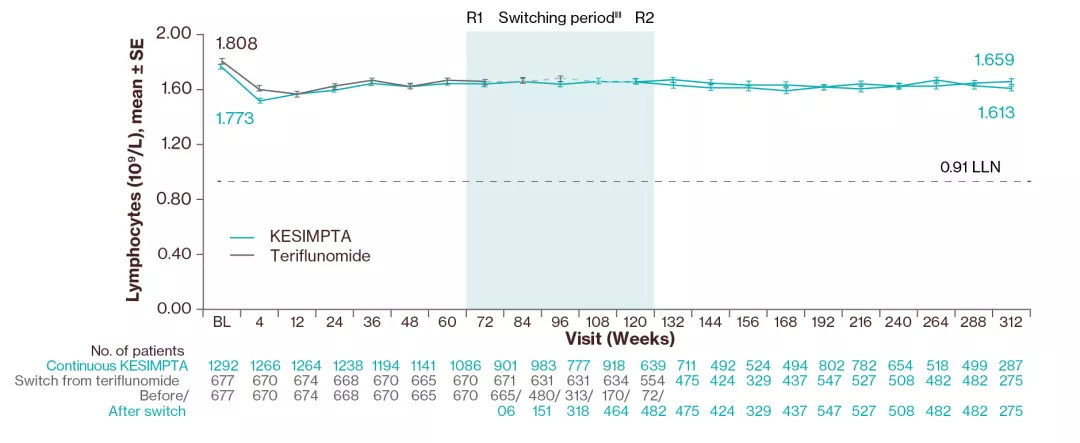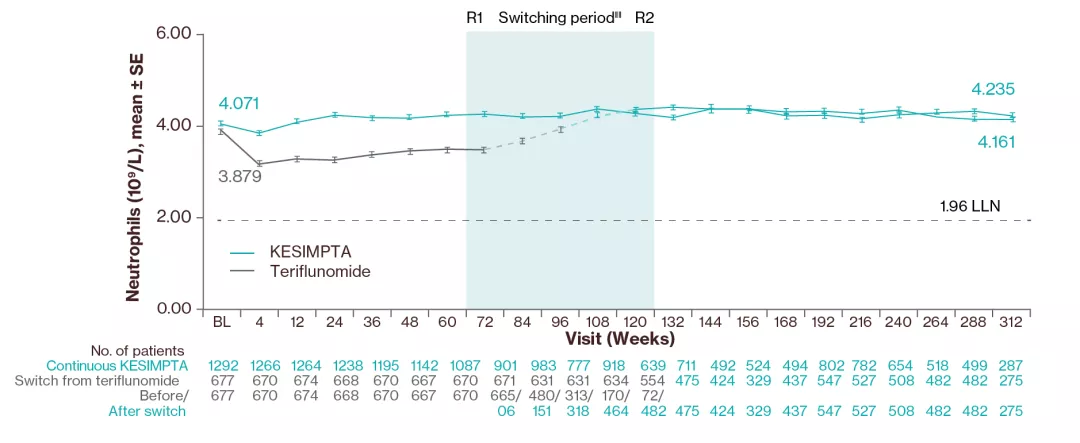KESIMPTA resources
Don’t miss out on these resources to support you and your patients.
This page is intended for UK healthcare professionals and other relevant decision makers only. If you are a member of the public, please click here.
This portal is funded and owned by Novartis Pharmaceuticals UK Ltd and includes content approved by Novartis.
Adverse events reporting information can be found in the footer of this page.
This link will take you to the electronic medicines compendium (emc) website, which is a non-Novartis website.
KESIMPTA is indicated for the treatment of adult patients with relapsing forms of multiple sclerosis (RMS) with active disease defined by clinical or imaging features.1
Please refer to the Summary of Product Characteristics (SmPC) for full safety information.
In ASCLEPIOS I and II:
| Core, ASCLEPIOS | Core + extension: Overall KESIMPTA, (N=1969) | Core + extension: RDTN KESIMPTA, (n=546) | ||||||
|---|---|---|---|---|---|---|---|---|
| KESIMPTA, n (%) | KESIMPTA, EAIR (95% CI) | TER, n (%) | TER, EAIR (95% CI) | n (%) | EAIR (95% CI) | n (%) | EAIR (95% CI) | |
| Participants with at least one AE | 791 (83.61) | 188.55 (175.86–202.16) | 788 (84.2) | 188.92 (176.18–202.58) | 1826 (92.7) | 112.95 (107.88–118.25) | 509 (93.2) | 124.96 (114.56–136.30) |
| Participants with at least one SAE | 83 (8.77) | 5.56 (4.48–6.89) | 73 (7.8) | 4.94 (3.93–6.21) | 342 (17.4) | 4.06 (3.65–4.51) | 87 (15.9) | 3.70 (3.00–4.57) |
| AEs leading to KESIMPTA discontinuation | 54 (5.70) | – | 49 (5.2) | – | 151 (7.7) | – | 52 (9.5) | – |
| Infections and infestations | 488 (51.58) | 51.14 (46.80–55.88) | 493 (52.7) | 52.59 (48.14–57.44) | 1423 (72.3) | 37.12 (35.24–39.10) | 411 (75.3) | 42.31 (38.41–46.60) |
| Serious infections | 24 (2.54) | 1.55 (1.04–2.31) | 17 (1.8) | 1.12 (0.69–1.80) | 123 (6.2) | 1.37 (1.15–1.63) | – | – |
| Serious infections (excluding COVID-19) | 24 (2.54) | 1.55 (1.04–2.31) | 17 (1.8) | 1.12 (0.69–1.80) | 78 (4.0) | 0.86 (0.69–1.07) | 16 (2.9) | 0.63 (0.39–1.03) |
| Serious COVID-19 infections | 0 | 0 | 0 | 0 | 51 (2.6) | 0.55 (0.42–0.73) | 18 (3.3) | 0.70 (0.44–1.12) |
| Blood Ig level† | ||||||||
| IgG decrease | – | – | – | – | 8 (0.5) | 0.09 (0.04–0.17) | 2 (0.4) | 0.08 (0.02–0.31) |
| IgM decrease | – | – | – | – | 284 (14.4) | 3.30 (2.94–3.71) | 79 (14.4) | 3.28 (2.63–4.09) |
| Injection-related systemic reactions | 195 (20.61) | 15.49 (13.46–17.83) | 143 (15.3) | 10.90 (9.25–12.84) | 516 (26.1) | 7.38 (6.77–8.04) | 142 (26.0) | 7.16 (6.08–8.44) |
| Injection-site reactions | 103 (10.88) | 7.21 (5.94–8.74) | 52 (5.55) | 3.54 (2.70–4.65) | 261 (13.3) | 3.16 (2.80–3.57) | 87 (15.9) | 3.86 (3.13–4.76) |
| Malignancies | 5 (0.53) | 0.32 (0.13–0.77) | 4 (0.4)‡ | 0.26 (0.10–0.69) | 29 (1.5) | 0.31 (0.22–0.45) | 10 (1.8) | 0.38 (0.21–0.72) |
| Deaths | 0 | – | 1§ | – | 12¶ | – | 7|| (1.3) | |
Adapted from Weindl H, et al. 2024,4 Hauser SL, et al. 20255 and Bittner S, et al. 2025.6
KESIMPTA (n=946) | Teriflunomide (n=936) | |
Any AEs | 791 (83.6) | 788 (84.2) |
Any serious AEs | 86 (9.1) | 74 (7.9) |
Most common AEs | ||
Injection-related reactions (systemic)** | 195 (20.6) | 143 (15.3) |
Nasopharyngitis | 170 (18.0) | 156 (16.7) |
Headache | 126 (13.3) | 116 (12.4) |
Injection-site reaction (local) | 103 (10.9) | 52 (5.6) |
Upper respiratory tract infection | 97 (10.3) | 120 (12.8) |
Urinary tract infection | 97 (10.3) | 78 (8.3) |
Back pain | 72 (7.6) | 58 (6.2) |
Fatigue | 71 (7.5) | 72 (7.7) |
Influenza | 62 (6.6) | 59 (6.3) |
Nausea | 61 (6.4) | 64 (6.8) |
Blood IgM decreased | 56 (5.9) | 21 (2.2) |
Alopecia | 54 (5.7) | 138 (14.7) |
Arthralgia | 49 (5.2) | 44 (4.7) |
Diarrhoea | 49 (5.2) | 111 (11.9) |
Pain in extremity | 46 (4.9) | 66 (7.1) |
Depression | 45 (4.8) | 48 (5.1) |
Hypertension | 35 (3.7) | 55 (5.9) |
Paraesthesia | 27 (2.9) | 52 (5.6) |
Data are n (%)
Adapted from Hauser SL, et al. 2020.2
Discontinuation: | KESIMPTA (n=946) | Teriflunomide (n=936) |
Due to an AE | 54 (5.7%) | 49 (5.2%) |
Due to an injection reaction (systemic) | 1 (0.1%) | N/A |
Adapted from Hauser SL, et al. 2020.2
EAIRs per 100 PYs of AEs and SAEs with up to 7 years of ofatumumab treatment remained generally consistent with that in the ASCLEPIOS I/II trials, with no unexpected safety concerns identified5
EAIRs of serious AEs, including infections and malignancies, remained consistent up to 7 years5
EAIR per 100 PYs is defined as the expected number of patients with the given event over 100 years of exposure to a treatment, assuming the event rate is constant over time. This is estimated by Poisson regression where participants’ time is taken until first event occurrence, or the last day the patient was at risk, for those who did not have the event.5
The most important and frequently reported adverse reactions are upper respiratory tract infections (39.4%), systemic injection-related reactions (20.6%), injection-site reactions (10.9%) and urinary tract infections (11.9%).1
| Infections and infestations | |
| Very common | Upper respiratory tract infections†† Urinary tract infections‡‡ |
| Common | Oral herpes |
| Immune system disorders | |
| Not known | Hypersensitivity reactions§§ |
| General disorders and administration site conditions | |
| Very common | Injection-site reactions (local) |
| Injury, poisoning and procedural complications | |
| Very common | Injection-related reactions (systemic) |
| Gastrointestinal disorders | |
| Common | Nausea, vomiting¶¶ |
| Investigations | |
| Common | Blood IgM decreased |
Adapted from KESIMPTA (ofatumumab) Summary of Product Characteristics.1
Please refer to the SmPC for full safety information.1
Frequency is categorised as: Very common (≥1/10); common (≥1/100 to <1/10); uncommon (≥1/1000 to <1/100); rare (≥1/10,000 to <1/1000); very rare (<1/10,000).1
Open-label, single-arm, multi-centre extension of ASCLEPIOS I/II, APLIOS and APOLITOS trials
Objective: to assess the longer-term safety and efficacy of KESIMPTA in people with relapsing multiple sclerosis (pwRMS)
Efficacy population for ALITHIOS included 1882 who entered from ASCLEPIOS I/II (including continuous and switch KESIMPTA groups). Safety population for ALITHIOS includes patients from APLIOS and APOLITOS. A total of 1969 patients were included in the safety analysis
At data cut-off, September 2024, patients had experienced up to 7 years of KESIMPTA treatment5
For further information on the clinical trials, please click here.
Use the arrows below to navigate to the RTDN subgroup data.


In the Phase III studies, KESIMPTA was associated with a transient decrease of 4.3% in mean IgG levels after 48 weeks of treatment but an increase of 2.2% after 96 weeks.1 The 7-year data reported interruptions/discontinuations in 3 (0.2%)/4 (0.2%) patients due to low IgG.5
In ASCLEPIOS I/II, the investigators were required to interrupt study treatment if IgM levels fell 10% <LLN or IgG levels fell 20% <LLN; due to a protocol amendment at the beginning of ALITHIOS (3 June 2021), the requirement to interrupt treatment based on a specific threshold due to low IgG/IgM was removed, and the decision was left to the discretion of the investigator.4
Use the arrows below to navigate to the RTDN subgroup data.


In the Phase III clinical studies, a decrease in mean value of IgM (30.9% decrease after 48 weeks and 38.8% decrease after 96 weeks) was observed.1
In the 7-year data, treatment interruptions/discontinuations due to low IgM was reported in 9.7%/4.2% RDTN patients.6
In ASCLEPIOS I/II, the investigators were required to interrupt study treatment if IgM levels fell 10% <LLN or IgG levels fell 20% <LLN; due to a protocol amendment at the beginning of ALITHIOS (3 June 2021), the requirement to interrupt treatment based on a specific threshold due to low IgG/IgM was removed, and the decision was left to the discretion of the investigator.4
Lymphocyte levels up to 6 years4
Adapted from Wiendl H, et al. 2024.4
Up to Year 7: A transient decline in the mean lymphocyte levels was observed up to Week 4 (% change: continuous, −11.9%; switch, −8.2%), followed by an increase back close to baseline levels in continuous KESIMPTA and switch groups which was sustained through Week 360.5
Neutrophil levels up to 6 years4
Adapted from Wiendl H, et al. 2024.4
Up to Year 7: In the continuous KESIMPTA group, the mean neutrophil level remained stable and above baseline for all visits up to Week 360; whereas in the switch group, the mean neutrophil level decreased up to Week 4 (−14.5%) and remained low during the pre-switch period followed by a reversal and stabilisation (reaching baseline levels) post-switch.5
*Patients in the teriflunomide arm received a matching placebo injection to ensure blinding (double-dummy design).2
†IgG and IgM levels remained above the LLN (5.65 g/L) in 96.8% and 64.5% of patients at all visits, respectively; the proportion of participants who interrupted ofatumumab treatment due to low IgG or IgM was 0.4% and 14%, respectively.5
‡One case of basal cell carcinoma was not listed as an SAE.4
§Death was due to aortic dissection.4
¶Including the following: Sudden death (n=1), oesophageal adenocarcinoma (n=1), completed suicide (n=1), COVID-19/COVID-19 pneumonia (n=1), COVID-19 (n=2), gastric ulcer perforation (n=1), COVID-19 pneumonia (n=1), intestinal metastasis (n=1), COVID-19 pneumonia/pneumothorax (n=1), pneumonia/septic shock (n=1) and injury (n=1).5
‖Including the following: Sudden death (n=1), oesophageal adenocarcinoma (n=1), completed suicide (n=1), aortic dissection (n=1), COVID-19/COVID-19 pneumonia (n=1) and COVID-19 (n=2).6
**Only reactions or symptoms that occurred within 24 hours after injection are included (i.e., time to onset of reaction ≤24 hours).2
††Grouping of preferred terms (PTs) was considered for adverse drug reaction (ADR) frequency determination and includes the following: nasopharyngitis, upper respiratory tract infection, influenza, sinusitis, pharyngitis, rhinitis, viral upper respiratory infection, tonsillitis, acute sinusitis, pharyngotonsillitis, laryngitis, pharyngitis streptococcal, viral rhinitis, sinusitis bacterial, tonsillitis bacterial, viral pharyngitis, viral tonsillitis, chronic sinusitis, nasal herpes and tracheitis.1
‡‡Grouping of PTs was considered for ADR frequency determination and includes the following: urinary tract infection, cystitis, Escherichia urinary tract infection, asymptomatic bacteriuria and bacteriuria.1
§§Reported during post-marketing experience.1
¶¶Nausea and vomiting have been reported in association with systemic injection-related reactions.1
‖‖Switching period refers to the participants started on teriflunomide and is not applicable to the participants on KESIMPTA in the core period. For the teriflunomide/KESIMPTA group, data from the first dose of teriflunomide until the last dose of KESIMPTA plus 100 days or analysis cut-off date has been used. R1: The first participant with first treatment-emergent assessment in KESIMPTA period after switching to KESIMPTA (72 weeks); R2: The last participant with last treatment-emergent assessment in teriflunomide period before switching to KESIMPTA (120 weeks). For all pooled analyses, a fixed value of LLN (using ALITHIOS study reference) was used: IgG: 5.65 g/L, IgM: 0.4 g/L, lymphocyte: 0.91x109/L and neutrophil: 1.96x109/L.4
ADR, adverse drug reaction; AE, adverse event; CI, confidence interval; COVID-19, coronavirus disease 2019; EAIR, exposure-adjusted incidence rate; HBcAb, hepatitis B core antibody; HBsAg, hepatitis B surface antigen; HBV, hepatitis B virus; Ig, immunoglobulin; IgE, immunoglobulin E; IgG, immunoglobulin G; IgM, immunoglobulin M; LLN, lower limit of normal; NA, not applicable; PML, progressive multifocal leukoencephalopathy; PT, preferred term; pwRMS, people with relapsing multiple sclerosis; PY, patient-year; RDTN, recently diagnosed treatment-naïve; RMS, relapsing forms of multiple sclerosis; SAE, serious adverse event; SC, subcutaneous; SE, standard error; SmPC, summary of product characteristics; TER, teriflunomide.
References
KESIMPTA (ofatumumab) Summary of Product Characteristics.
Hauser SL, et al. N Engl J Med 2020;383(6):546–557 and supplementary material.
Pardo G, et al. P7.016. American Academy of Neurology Annual Meeting. 5–9 April 2025, San Diego, CA, US.
Wiendl H, et al. P9.010. American Academy of Neurology Annual Meeting. 13–18 April 2024, Denver, CO, US.
Hauser SL, et al. P804. European Committee for Treatment and Research in Multiple Sclerosis Annual Congress. 24–26 September 2025. Barcelona, Spain.
Bittner S, et al. P805. European Committee for Treatment and Research in Multiple Sclerosis Annual Congress. 24–26 September 2025, Barcelona, Spain.
UK | October 2025 | 443397-1
Adverse events should be reported. Reporting forms and information can be found at www.mhra.gov.uk/yellowcard. Adverse events should also be reported to Novartis online through the pharmacovigilance intake (PVI) tool at www.novartis.com/report, or alternatively email [email protected] or call 01276 698370.


